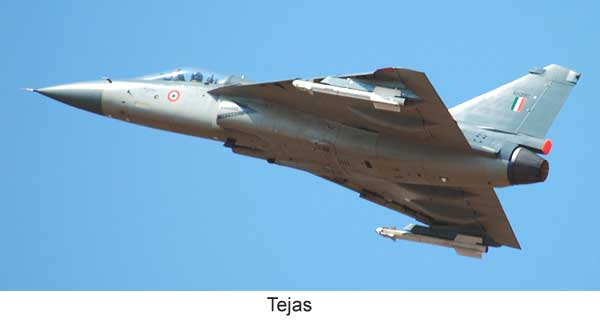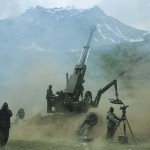 The peremptory rejection of the shipborne variant of Tejas Light Combat Aircraft (LCA) by the Indian Navy (IN) seems to have surprised most navy-watching analysts. Their confusion has been compounded by the near-simultaneous issuance of a global request for information (RFI) for procurement of “57 multirole fighters for its aircraft carriers” by Naval HQ. One can deduce two compelling reasons for this, seemingly, radical volte face by the only service which has shown unswerving commitment to indigenisation (lately labelled ‘Make in India’) for the past six decades.
The peremptory rejection of the shipborne variant of Tejas Light Combat Aircraft (LCA) by the Indian Navy (IN) seems to have surprised most navy-watching analysts. Their confusion has been compounded by the near-simultaneous issuance of a global request for information (RFI) for procurement of “57 multirole fighters for its aircraft carriers” by Naval HQ. One can deduce two compelling reasons for this, seemingly, radical volte face by the only service which has shown unswerving commitment to indigenisation (lately labelled ‘Make in India’) for the past six decades.
Firstly, by exercising a foreclosure option, the IN has administered a well-deserved and stinging rebuke to the Defence Research & Development Organisation (DRDO) for its lethargic and inept performance that has again disappointed our military. The second reason arises from the navy’s desperate hurry to freeze the specifications of its second indigenous aircraft carrier (dubbed IAC-2). The choice of configuration, size and propulsion of a carrier has a direct linkage with the type of aircraft that will operate from it. This constitutes a ‘chicken and egg’ conundrum — should one freeze the carrier design first or choose the aircraft first? The IN has, obviously decided the latter.
The IAC-2 will enter service, in the next decade, at a juncture where a balance-of-power struggle is likely to be under way in this part of the world — with China and India as the main players. It is only a matter of time before China’s carrier task-forces, led by the ex-Russian carrier Liaoning and her successors, follow its nuclear submarines into the Indian Ocean. Since the Indian response to such intimidation will need to be equally robust, the decisions relating to the design and capabilities of IAC-2 (and sisters) assume strategic dimensions. Essentially, there are three options for selection of aircraft for the IAC-2.
- Conventional take-off and landing types like the US F/A-18 Super Hornet and French Rafale-M that would require a steam catapult for launch and arrester-wires for recovery. The relatively large ship would need either a steam or nuclear plant for propulsion.
- Types like the Russian Sukhoi-33 and MiG-29K would require only a ski-jump for take-off and arrester-wires for landing. This would mean a smaller ship, driven either by gas turbines or diesel engines. The LCA (Navy) could have been a contender in this category.
- The F-35B Lightning II version of the US Joint Strike Fighter, capable of vectored-thrust, would require only a ski-jump for take-off, but no arrester wires since it can land vertically. This would result in the simplest and cheapest ship; a short take-off and vertical landing (STOVL) carrier.
Once the IN has selected an aircraft, the ship and its operating and maintenance facilities can be designed around it avoiding some of the pitfalls encountered on IAC-1.
Reverting to the LCA saga — as far back as the early 1990s, the navy had initiated a study for examining the feasibility of adapting the LCA to shipborne use. While confirming feasibility, the study had revealed some major problem areas, which included lack of engine thrust, requirement of an arrester hook and stronger undercarriage, and need for cockpit/fuselage re-design before the LCA could attempt carrier operations. Undaunted, the Navy re-affirmed its faith in the programme by contributing over Rs 400 crore as well as engineers and test pilots to the project.
The IAF accepted the Tejas into service, in July 2016, with considerable reservations because it had not been cleared for full operational exploitation and fell short of many IAF qualitative requirements. The prototype of LCA (Navy) had rolled out six years earlier, in July 2010, raising great hopes in the IN. However, it is obvious that the DRDO failed to address the problems listed above with any urgency, leading to ultimate rejection of this ambitious project.
By its failure to deliver on the LCA (Navy), the DRDO has let down its most steadfast supporter amongst the armed forces — the navy. A little introspection by those at the helm of this organisation would reveal to them three reasons for its abysmal performance despite a wealth of talent and a network of sophisticated laboratories — an exaggerated opinion of their capabilities; a lack of intellectual honesty in denying obvious failures and an unwillingness to seek external help when required.
Today, India has the ignominious distinction of being the world’s biggest importer of military hardware, whereas China counts amongst the world’s leading arms exporters and its aeronautical establishment has delivered aircraft ranging from UAVs to 5th generation fighters, helicopters and transports to the PLA.
While one would be justified in blaming the scientists and bureaucrats responsible for defence research and production, the root cause of this colossal failure lies in political indifference and the inability to provide vision and firm guidance to our massive but under-performing military-industrial complex.
Courtesy: http://southasiamonitor.org/news/whither-navy-s-lca-/sl/21944





Admiral sahib,
This is an episode of shame that the IN has exploited fully to cover itself in shame! The arrogance of pinning the blame on the DRDO is remarkable. But the whole saga of the Navy’s handling of aircraft carrier purchases and fighters to fly off them seems to point a large finger back at the Navy. I wonder why you find it so hard to fathom the situation correctly.
The Navy ordered the initial batch of Mig-29ks for the Gorshkov and operated these for some years before ordering a follow on batch of additional Mig-29ks. Did the Navy hide the data on the poor operational serviceability of the aircraft so that it could buy additional 29ks? Why is there a sudden realization now of the problems with the 29s?
Can the Navy’s aviation wing now be trusted with its derision of the NLCA Mk2 which is being developed to operate off the Navy’s aircraft carriers?
Only Indians consider deriding their industry a matter of pride. We have failed to appreciate our independence. An extremely sad state of affairs where we need to hold the hands of foreign interests for national security. I guess the leak of all operational data regarding the so-called “stealthy Scorpenes” for a fistful of dollars has not had any impact on the Indian defence establishment.
Sir….you have hit the nail on the head….but has this not been the story thus far. The DRDO…DPSUs all have been a failure (I would like to put this word in Upper Case)…barring for a few success stories that can be counted on ones finger-tips.
As a matter of interest…and pardon my ignorance….what do other nations like USA…Russia…China do when they design a carrier…..do they first think about the size and propulsion systems or do they think about the ac. In my opinion, it should be the former, the ac can then be decided later, even if entails modifying a shore-based ac.
Can the Navy able to convince the defense minister for the necessity of purchasing fighter plane from foreign countries for the aircraft carrier knowing well it is a white elephant? It is only a status simple. India is committed to “Loka Samastha Sukhino Bhavanthu” None of the Aircraft carrier, Warship, Frigates will and be able to escape from multiple missiles attacks and super cavitating torpedoes. In 1982 Falkland war the Exocet missiles that struck the Sheffield impacted on the starboard side at deck level 2, travelling through the junior ratings scullery and breaching the Forward Auxiliary Machinery Room/Forward Engine Room bulkhead 2.4 metres (7 ft 10 in) above the waterline, creating a hole in the hull roughly 1.2 by 3 metres (3.9 by 9.8 ft). It appears that the warhead did not explode.[15] Accounts suggest that the initial impact of the missile disabled the ship’s electrical distribution systems and breached the pressurized sea water fire main, severely hampering any firefighting response and eventually dooming the ship to be consumed by the fire. The loss of Sheffield was a deep shock to the British public and government. Argentina did not get sufficient number of the missiles from France. This was the condition about 25 years back.The defense minister knows all these things. The USA, Russia, and China knows this and will avoid any direct confrontation. iF the Navy wants to use the Aircraft carrier developed by
India they can use 20 Mig 29 K out of 41 purchased from India.
” India is committed to “Loka Samastha Sukhino Bhavanthu”
This can happen only when our enemies are destroyed and our friends helped. Being a helpless pawn does not lead to sukham- cowardice and learned helplessness are not part of our culture or advocated anywhere. People who want our country to eternally remain a slave to others are thus misrepresenting our culture.
Do not think you are an are an expert. The Indian defense officers never care for the Human life. Whereas the USA and western countries. always try to reduce war casualties. The UK do not have any Aircraft carrier. Russia and France have only one Aircraft carrier. The USA is not using Aircraft carrier. They are using warship or frigate to launch the Tomahawk is a long-range, all-weather, subsonic cruise missile and UAV to save the human. life. To maintain an Aircraft carrier more than 1000 crews are required. In a modern war, it is suicidal to use Aircraft craft carrier. That they had seen in the Falkland war. None of the Aircraft carriers will be able to escape from super-cavitating torpedoes developed by Russia and now China has purchased from Russia. That is the main reason the USA is avoiding direct confrontation with Russia and China. To impose a Naval blockade near Nicobar Island no Aircraft carrier is required. A few missile boats and depth charges are only required.